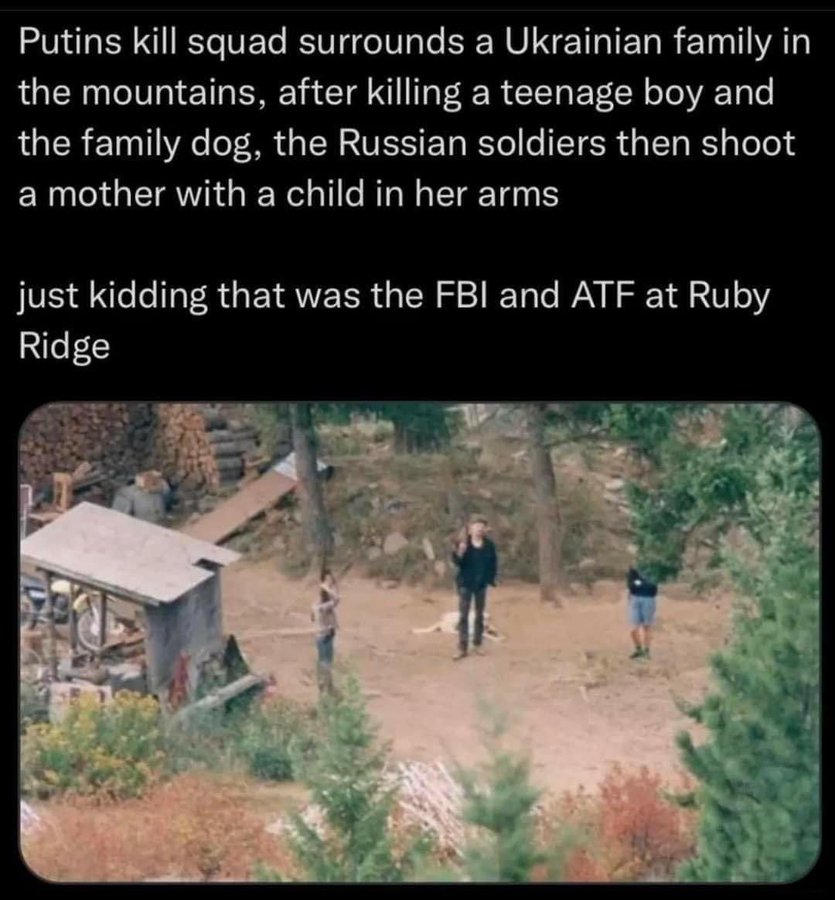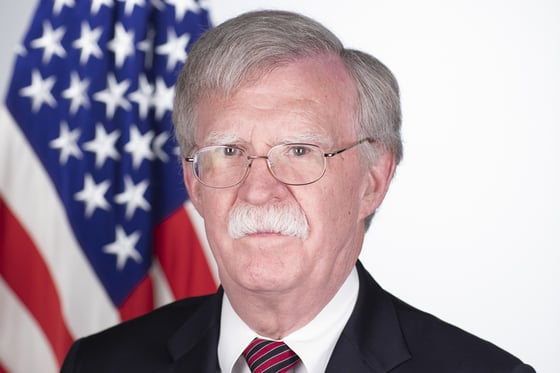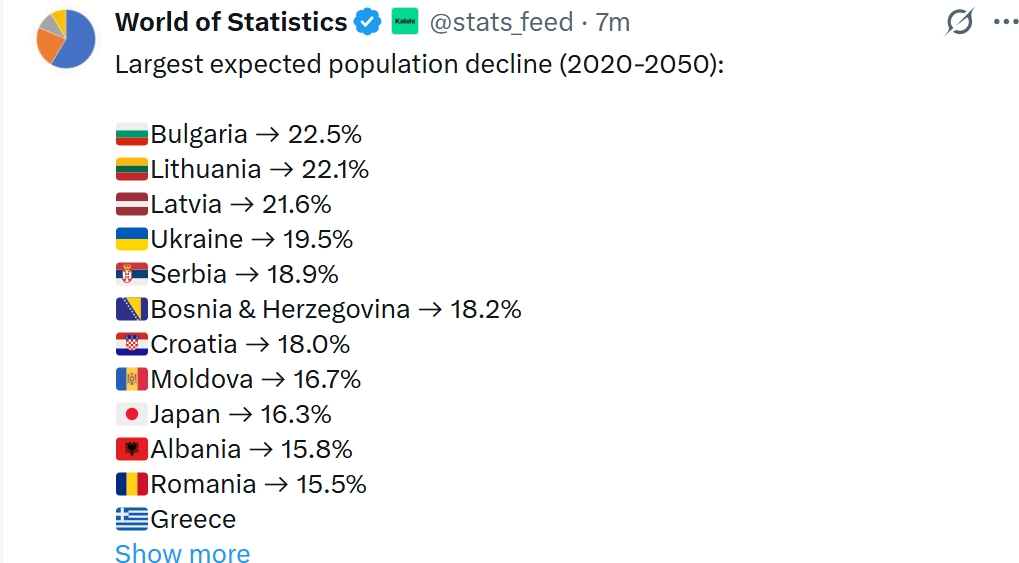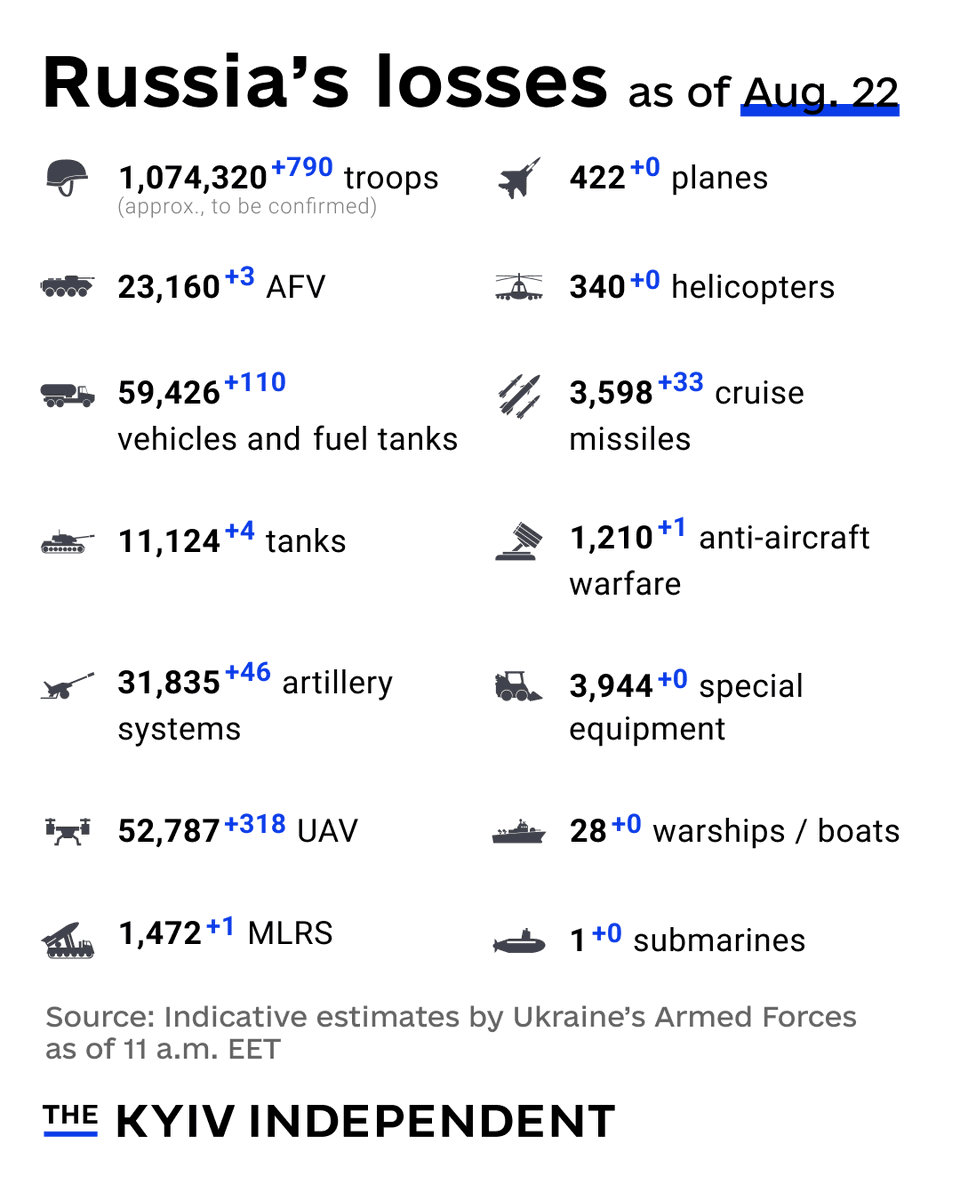Posted on 02/24/2024 5:59:01 AM PST by SpeedyInTexas
This list only includes destroyed vehicles and equipment of which photo or videographic evidence is available. Therefore, the amount of equipment destroyed is significantly higher than recorded here. Loitering munitions, drones used as unmanned bait, civilian vehicles and derelict equipment are not included in this list. All possible effort has gone into avoiding duplicate entries and discerning the status of equipment between captured or abandoned. Many of the entries listed as 'abandoned' will likely end up captured or destroyed. Similarly, some of the captured equipment might be destroyed if it can't be recovered. When a vehicle is captured and then lost in service with its new owners, it is only added as a loss of the original operator to avoid double listings. When the origin of a piece of equipment can't be established, it's not included in the list. The Soviet flag is used when the equipment in question was produced prior to 1991. This list is constantly updated as additional footage becomes available.
(Excerpt) Read more at oryxspioenkop.com ...
Ukraine has lost 1.7 million servicemen during the special military operation, these are killed and missing in action.
The information comes from the database of the Ukrainian General Staff, which was hacked by killnet.
pic.twitter.com/QduW41ioP4— Lord Bebo (@MyLordBebo) August 20, 2025


“Russian President Vladimir Putin cannot be trusted to honor any promises or commitments to permanently cease military activity against Ukraine and that any security guarantees must be robust and credible to deter the Russian military command does not re-group and launch a future invasion of Ukraine.”
I keep wondering if anybody in the White House or State Dept. are even aware of Alexandr Dugin’s opus on how Russia can conquer Europe and control most of the world. Here is the link that gives 20+ steps to take to achieve Russian expansionist goals:
https://en.wikipedia.org/wiki/Foundations_of_Geopolitics
Perhaps write a short statement of why you think what you are sending is important, and enclose a copy of the 20+ bullet pointed plans. There is a reason Dugin is referred to as “Putin’s Brain” and there it is in all its gorey.
It’s a pretty striking resemblance.
—
The guy has H.G. Wells’ time machine?
47 may nave just green-lit a Russian invasion of the nation of Georgia. Waiting for links
Unecha oil pumping station in Bryansk region is burning brightly after Ukrainian drone strike just now.

Keith Kellogg to travel to Kyiv tomorrow per Reuters. 👀
Turns out the guy in the middle was Putin’s translator.
Since ‘Putin’ may have been a body double, this guy, who was present at the Noxious Nixon-Khrushchev meeting as Khrushchev’s translator in 1959, maybe he is a body double as well. He is remarkably well preserved, over the intervening 66 years, at some 90 plus years of age. Else the Russians have the secret of anti-aging.
Does that include gasoline and diesel (when they can get some)😂

Ed Martin here, wishing all you Ukranian whackjobs a good morning!

Russians claim they found the facility in southern Kyiv, and a UAV is already above the target.
Claimed Iskander is already being directed there, now we waithttps://t.co/rI8XNgPDhI pic.twitter.com/NnsMhAMKZY— WarVehicleTracker🇵🇱 ☧ (@WarVehicle) August 22, 2025

The Kremlin continues to insist that the 2022 Istanbul negotiations are the only acceptable departure point for potential future negotiations on the war in Ukraine, thereby demanding that Russia and its allies reserve the right to veto any Western military assistance to Ukraine and that Ukraine be left neutered and defenseless against future Russian aggression. Russian Foreign Minister Sergey Lavrov stated during a joint press conference with Indian External Affairs Minister Subrahmanyam Jaishankar on August 21 that Russia will proceed on the issue of security guarantees for Ukraine based on its experience with the 2015 Minsk II agreement and 2022 Istanbul negotiations.[1] Lavrov claimed that the 2022 Istanbul negotiations were based on the concept of “eliminating the root causes” of the war in Ukraine, referencing the Kremlin's oft-evoked accusation that the “root causes” of the war include NATO's eastward expansion and Ukraine's alleged discrimination against Russian speakers and the Moscow-linked Ukrainian Orthodox Church.[2] Lavrov claimed that the 2022 Istanbul negotiations would have ensured Ukraine's security “honestly and collectively” via a group of guarantor countries including United Nations Security Council (UNSC) permanent members, Germany, and Turkey. Lavrov similarly stated on August 20 during a meeting with Jordanian officials that Russia was ready to sign on to an agreement based on the 2022 Istanbul negotiations and that those negotiations are a “good example” of a way to negotiate an end to the war.[3]
Lavrov’s recent statements lauding the 2022 Istanbul negotiations suggest that the Kremlin has selected Lavrov to be the predominant amplifier of the longstanding Russian narrative that the Istanbul negotiations are the necessary starting point for negotiations. An agreement based on the 2022 Istanbul negotiations would have crippled Ukraine by permanently banning it from joining NATO, imposing draconian limitations on the size of the Ukrainian military, and prohibiting Ukraine from receiving any Western military assistance.[4] The draft agreement also demanded that Russia and the UNSC, including the People's Republic of China (PRC, a key Russian ally), be granted the status of guarantor states and that guarantor states must act in concert in the event of a violation of the agreement, which would allow Russia to veto Western military assistance for Ukraine.[5] The draft Istanbul agreement notably imposes no limitations on Russia's military capabilities—effectively neutering Ukraine politically and militarily while protecting Russia's ability to reinvade Ukraine in the future on much more favorable terms even than it faced in 2022. The Kremlin likely understands that the 2022 Istanbul framework is a non-starter for Kyiv and therefore continues to invoke it in an effort to paint Ukraine as unwilling to negotiate while Moscow continues to delay good-faith peacemaking efforts.
The Kremlin continues to categorically reject US-backed security guarantees for Ukraine and reveal its continued objectives of seizing control of all of Ukraine. Russian Security Council Deputy Chairperson Dmitry Medvedev explicitly rejected US- and European-led efforts to provide Ukraine with reliable security guarantees by reiterating on his English-language X (formerly Twitter) account on August 20 that “[Russia has] explicitly stated: No NATO troops as peacekeepers” and that Russia will not accept such a security guarantee.[6] Medvedev claimed that Ukraine does not need such security guarantees, contrary to the Trump administration's position on Ukraine's need for robust security guarantees.[7] Russian State Duma Deputy Alexei Zhuravlev claimed on August 21 that Ukraine should emulate Finland's negotiation model following World War II and become a neutral state and cede part of its territory and that negotiations will be based on battlefield dynamics.[8] State Duma Deputy Dmitry Belik echoed Zhuravlev's sentiments by claiming that Ukraine's attempts to alter its own territorial borders ignores the realities on the ground.[9] Kremlin officials often use the idea of “realities on the ground” to claim that Russia is in a superior position on the battlefield and to demand that Ukraine concede to Russia's demands.[10] Chairperson of the Russian Federation Council Committee on International Affairs Grigory Karasin claimed on August 21 that stakeholders must understand that Russia is concerned about its strategic security vis a vis Europe and NATO and that this raises questions about the overall viability of the entire negotiation process.[11] Several Kremlin officials claimed that Russia is defending new territories that are enshrined in Russia's Constitution and therefore international recognition of Russia's annexation is unnecessary, obfuscating the fact that Russia's occupation and annexation of Crimea and Kherson, Zaporizhia, Donetsk, and Luhansk oblasts is illegal under international law.[12] Kherson Oblast occupation governor Vladimir Saldo claimed that Donbas and Novorossiya – which Russian officials have defined as all of eastern and southern Ukraine – are original Russian lands and cannot be part of any territorial concession to Ukraine.[13] Russian reserve Colonel Viktor Baranets claimed on August 20 that Russia may allow European peacekeeping troops in Ukraine in exchange for Ukraine ceding all of its southern oblasts, including Odesa, Mykolaiv, and perhaps Kharkiv, to Russia.[14] Russia notably does not occupy any part of Odesa Oblast and occupies slivers of Kharkiv and Mykolaiv oblasts.
Reuters, citing three sources familiar with top-level Kremlin thinking, reported on August 21 that Putin continues to demand that Ukraine cede all of eastern Donbas, renounce ambitions to join NATO, establish itself as a neutral state, and refuse to host Western troops.[15] The sources added that Putin told US officials that he is willing to freeze Russian offensive operations in Zaporizhia and Kherson oblasts in exchange, as well as return small, unspecified parts of Kharkiv, Sumy, and Dnipropetrovsk oblasts. The sources reported that Putin continues to demand that NATO fundamentally alter one of its core tenets and commit to a legally binding pledge not to expand eastward, a demand that would require the renegotiation and re-ratification of the NATO treaty by all NATO member states. Lavrov recently stated that the Kremlin's objective is to politically control all of Ukraine rather than to seize select Ukrainian territories such as Donetsk Oblast, further demonstrating that Russia remains unwilling to accept any agreement that falls short of Ukraine's full capitulation.[16] US President Donald Trump and US Vice President JD Vance have recently expressed the United States’ willingness to contribute to the safeguarding of measures to prevent Russia from resuming its war in Ukraine.[17]
Russia is expending considerable diplomatic effort to court India, suggesting that the Kremlin continues to fear the impact of secondary sanctions. Russian President Vladimir Putin and Russian Foreign Minister Sergey Lavrov met with Indian Foreign Minister Subrahmanyam Jaishankar on August 21 to discuss Russian-Indian relations and expanding economic investment in energy, including the oil supply, hydrocarbons, and nuclear energy.[18] Russian Deputy Energy Minister Roman Marshavin met with Indian Deputy Minister of Petroleum and Natural Gas Pankaj Jain on August 20 to discuss expanding cooperation in the energy trade.[19] Lavrov held a joint conference with Jaishankar after the meeting and announced that Putin would likely visit India before the end of 2025, and Jaishankar stated that India ”believe[s] that relations between India and Russia have been among the steadiest of the major relationships in the world after the Second World War.”[20] Putin and other high-ranking Russian officials are spending considerable amounts of time and energy to stabilize and strengthen relationships with India, indicating that Russia views India as a critical source of revenue. ISW continues to assess that secondary sanctions will likely further impact the Russian economy by undercutting Russian oil revenues, which are essential for the Kremlin's financing of its war against Ukraine.[21] Intensive Russian outreach to India suggests that Moscow is attempting to ensure that New Delhi does not curtail energy purchases from Russia because of these potential secondary sanctions.
Russia launched the third largest strike of the war thus far against Ukraine on the night of August 20 to 21, targeting Western regions of Ukraine and causing significant damage to civilian infrastructure. The Ukrainian Air Force reported that overnight, Russian forces launched 574 Shahed-type and decoy drones from over Kursk, Oryol, and Bryansk cities, Millerovo, Rostov Oblast, Shatalovo, Smolensk Oblast, Primorsko Akhtarsk, Krasnodar Krai, and occupied Hvardiiske, Crimea; four Kh-47 Kinzhal aeroballistic missiles from over Lipetsk and Voronezh oblasts; two Iskander-M/KN-23 ballistic missiles from over Voronezh Oblast; 19 Kh-101 cruise missiles from over Saratov Oblast; 14 Kalibr cruise missiles from over the Black Sea; and one unidentified missile from over occupied Crimea.[22] Ukrainian forces reportedly downed 546 drones, one Kh-47 Kinzhal aeroballistic missile, 18 Kh-101 cruise missiles, and 12 Kalibr cruise missiles.[23] The Ukrainian Air Force reported that drones and missiles struck 11 locations throughout Ukraine.[24] Ukrainian officials reported that Russian drones and missiles struck infrastructure in Lviv City; Lutsk, Volyn Oblast; Rivne Oblast; and Zakarpattia Oblast, causing civilian injuries and deaths.[25] Russia's August 20-21 strike notably targeted several areas in Ukraine's far-western oblasts that border Hungary, Slovakia, and Poland. Russia launched a cruise missile at Mukachevo, Zakarpattia Oblast, striking the “Flex” US electronics manufacturing company and causing a massive fire and injuring at least 19 employees.[26] Ukrainian President Volodymyr Zelensky stated that “Flex” was a US-owned civilian enterprise that manufactured household goods such as coffee machines.[27] Russia likely struck the “Flex” enterprise to discourage the United States and Ukraine's European allies from investing in Ukraine or opening businesses within Ukraine.
Russia likely prepared for this strike for several weeks, stockpiling drones and missiles over the backdrop of ongoing US-Russian negotiations and the August 15 Alaska summit.[28] ISW observed that Russia was launching much smaller strike packages in the weeks leading up to the Alaska summit in order to posture itself to the United States as a good-faith negotiator, and assessed that Russia was likely to leverage the smaller-scale strikes to stockpile drones and missiles for renewed massive strikes on Ukraine following the summit.[29] The size and composition of the August 20-21 strike package suggest that Russia successfully stockpiled significant numbers of both drones and missiles in the lead-up to the Alaska summit. Russian forces most recently launched Kalibr cruise missiles on July 21 and Kinzhals on August 4, suggesting that efforts to stockpile these munitions allowed Russia to use them in greater quantities during the August 20-21 strike series.[30]

https://www.understandingwar.org/backgrounder/russian-offensive-campaign-assessment-august-21-2025

Hopefully first of many
Patriarch Kirill is confident that Putin will be canonized, and expects miracles at the front.
The head of the Church expressed the opinion that Vladimir Putin will be canonized soon after his death in a conversation with his closest associates. “Vladimir Vladimirovich has done so much that his canonization is beyond doubt. It is a pity that we cannot declare a person a saint during his lifetime. But I am sure that after the death of Vladimir Vladimirovich, the minimum terms will pass, and he will be canonized,” Patriarch Kirill said.
He also said that an icon depicting Putin will soon be ready and sent to the front (we wrote about it). According to the Primate of the Russian Orthodox Church, this icon “will definitely manifest great miracles.” The patriarch's associates agree with his opinion on the canonization of the president. But they believe that Kirill himself may well become a saint of the Russian Church, and one of the most revered.
https://t.me/kremlin_secrets/6074
Much more talk about Putin's death in the last month...
Disclaimer: Opinions posted on Free Republic are those of the individual posters and do not necessarily represent the opinion of Free Republic or its management. All materials posted herein are protected by copyright law and the exemption for fair use of copyrighted works.